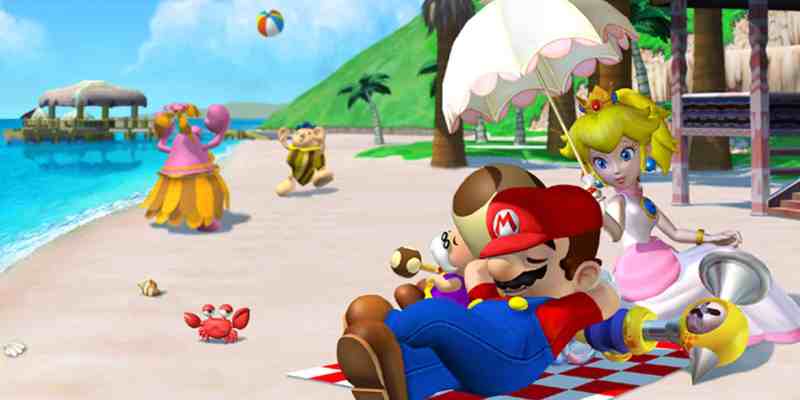Super Mario Sunshine: If those three words don’t send a chill down your spine, then you’re probably not a Nintendo fan. Other related terms that might spark some heebie-jeebies include “FLUDD,” “Blue Coins,” “unskippable cutscenes,” and, God forbid, “camera.” The Nintendo mascot’s second full-length 3D romp has picked up quite the negative reputation since first releasing nearly 20 years ago — and for good reason. A short development cycle suggested Nintendo fans may be getting a half-baked sequel to an all-time great, but there’s more to the story than that. Mario’s graffiti-cleaning, water-spraying, Blue Coin-filled adventure recently got a new coat of paint in Super Mario 3D All-Stars that highlights exactly why it is no less special than what came before.
3D All-Stars is a collection of quality and a testament to timeless design. A disgusting lack of enhancements and abysmal accessibility options aside, it’s hard to say the three-pack isn’t a blast to play through. Like many, I chose to start my nostalgic journey with the pièce de résistance – Super Mario 64. How Nintendo managed to nail traversal in 3D environments and worlds built around the player on the first go is beyond me, and it may be one of the greatest games ever made. I can only imagine the expectations that filled the minds of hopeful fans in the ‘90s as the ending credits left the screen. Whatever came next had to be perfect, right?
Right?
Let’s take a step back for a moment. How often do we see huge creative risks in the gaming industry? The kind that may prove fruitless but still represent a desire to be unique, strange, genre-defying, and, above all else, fun? Without the ambition to take new creative leaps, we’d all be stuck with games that reiterate the same tired formula again and again.

So, with that in mind, what if, after saving the Mushroom Kingdom in Super Mario 64, Mario went to jail and had to use his talking water jetpack to clear his name, clean a city, and beat Bowser in a hot tub of green jelly? The six-year lead-up to Super Mario Sunshine saw most fans anticipating “Super Mario 128,” a proposed sequel with a bigger world and otherwise more of the same gameplay. Of course, reality brought something slightly different, and playing it through the Super Mario 3D All-Stars lens means you might get whiplash jumping between the two.
FLUDD is introduced as Mario’s trusty companion and platforming cushion. There’s also a much larger emphasis on story, which features more than a few fully voiced cutscenes and a lot more law and order. You can also throw the long jump out the window and meet your new friend, the dive. The developers of Super Mario Sunshine certainly took risks even if some didn’t quite pay off.
The Super Mario Sunshine team, led by Yoshiaki Koizumi and Kenta Usui, took the expectations laid by the game’s monumental predecessor and lit them on fire to varying results. Though inspired, FLUDD doesn’t always work with the camera, and it’s unlikely that extra development time would have ever solved that problem. A focus on the tropical vacation getaway theme meant sacrificing the abstract potential seen in the levels of Super Mario 64. These changes came at a cost that many fans have not forgiven even 20 years later. Saying there was a shift from Super Mario 64 to Super Mario Sunshine doesn’t begin to describe how different it is as a sequel.

But therein lies the beauty of what Super Mario Sunshine was always meant to be. Mario games were never just about triple jumps, mushrooms, and fighting Bowser – they have been and always will be a bastion of creativity, innovation, and risks. On the heels of Super Mario 64, Koizumi and Usui chose to be bold instead of pandering to those dreaming about whatever they thought Super Mario 128 would be. Of course, time constraints meant the team had less room to scrap ideas that were maybe too risky, but it’s hard to imagine that an extra year would have meant FLUDD or the island setting would have been omitted in favor of something safer.
FLUDD, as weird as it is, represents Mario at its best. Though maybe not as universally praised as the anti-gravity shenanigans Mario would find himself in with Super Mario Galaxy some years later, it’s similarly innovative in how it enables new sorts of maneuverability. Even in 2020, platformers have yet to perfect camera controls, so it’s a little easier to forgive the occasional wonkiness in Mario’s GameCube outing. Isle Delfino remains an impressive example of a segmented, cohesive world despite the technical limitations at the time, as peering out over the sun-kissed waters to see an undiscovered location creates a sensation of scale and progression.
The controls born out of FLUDD’s inclusion result in a snappy 3D platformer, too, and this has never been more present than on Nintendo Switch with Super Mario 3D All-Stars. Super Mario Galaxy feels a little sluggish comparatively, and Super Mario 64, albeit revolutionary, still has a few kinks that could have been worked out. FLUDD expands Mario’s move set in a way that other titles never explored until 2017 with Super Mario Odyssey, a title that Koizumi served as producer on.

Maybe story cutscenes should be skippable, sure, but what they do offer in Super Mario Sunshine is a zany, not-too-serious reason for players to feel engaged from the get-go. Since when has a Mario game ever not started with a kidnapped Peach? That’s not to say that story is ever the focus in these types of games – it’s not. However, a bit of a shakeup doesn’t hurt anyway, and while Super Mario Sunshine does devolve into little more than a rescue mission later, the core idea of clearing Mario’s name and chasing down an imposter never ceases.
The point is Super Mario Sunshine took risks that the plumber’s other games never dared to take. Nintendo got weird with the follow-up to what many refer to as the most important game ever made, and that in and of itself is worth commending. If you can never forgive Blue Coins, I get it; they’re 240 collectible wastes of time. But I do hope you can still see this rushed game as something that took chances instead of allowing the weight of what came before to keep it from lifting off.
Now show me Super Mario Sunshine 2, Nintendo.
